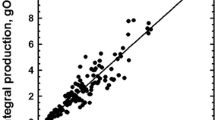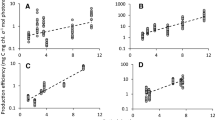Abstract
Daily and annual integrated rates of primary productivity and community respiration were calculated using physiological parameters measured in oxygen-based photosynthesis-irradiance (P-I) incubations at 8 stations throughout central and western Long Island Sound (cwLIS) during the summer and autumn of 2002 and 2003 and the late spring of 2003. Each calculation takes into account actual variations in incident irradiance over the day and underwater irradiance and standing stock with depth. Annual peak rates, ±95% confidence interval of propagated uncertainty in each measurement, of gross primary production (GPP, 1,730±610 mmol O2 m−2 d−1), community respiration (Rc, 1,660±270 mmol O2 m−2 d−1), and net community production (NCP, 1,160±1,100 mmol O2 m−2 d−1) occurred during summer at the western end of the Sound. Lowest rates of GPP (4±11 mmol O2 m−2 d−1), Rc (−50±300 mmol O2 m−2 d−1), and NCP (−1,250±270 mmol O2 m−2 d−1) occurred during late autumn-early winter at the outer sampled stations. These large ranges in rates of GPP, Rc, and NCP throughout the photic zone of cwLIS are attributed to seasonal and spatial variability. Algal respiration (Ra) was estimated to consume an average of 5% to 52% of GPP, using a literature-based ratio of Ra:Rc. From this range, we established that the estimated Ra accounts for approximately half of GPP, and was used to estimate daily net primary production (NPP), which ranged from 2 to 870 mmol O2 m−2 d−1 throughout cwLIS during the study. Annual NPP averaged 40±8 mol O2 m−2 yr−1 for all sampled stations, which more than doubled along the main axis of the Sound, from 32±14 mol O2 m−2 yr−1 at an eastern station to 82±25 mol O2 m−2 yr−1 at the western-most station. These spatial gradients in productivity parallel nitrogen loads along the main axis of the Sound. Daily integrals of productivity were used to test and formulate a simple, robust biomass-light model for the prediction of phytoplankton production in Long Island Sound, and the slope of the relationship was consistent with reports for other systems.
Similar content being viewed by others
Literature Cited
Anderson, T. H. andG. T. Taylor. 2001. Nutrient pulses, plankton blooms, and seasonal hypoxia in western Long Island Sound.Estuaries 24:228–243.
Balch, W. M. andC. F. Byrne. 1994. Factors affecting the estimation of primary production from space.Journal of Geophysical Research 99:7555–7570.
Behrenfeld, M. J. andP. G. Falkowski. 1997. A consumer's guide to phytoplankton primary productivity models.Limnology and Oceanography 42:1479–1491.
Behrenfeld, M. J., E. Maranon, D. A. Sigel, andS. B. Hooker. 2002. Photoacclimation and nutrient-based model of light-saturated photosynthesis for quantifying oceanic primary production.Marine Ecology Progress Series 228:103–117.
Bender, M., K. Grande, K. Johnson, J. Marra, P. J. L. Williams, J. Sieburth, M. Pilson, C. Langdon, G. Hitchcock, J. Orchardo, C. Hunt, P. Donaghay, andK. Heinemann. 1987. A comparison of four methods for determining planktonic community production.Limnology and Oceanography 32:1085–1098.
Bender, M., J. Orchardo, M. L. Dickson, R. Barber, andS. Lindley. 1999. In vitro O2 fluxes compared with14C production and other rate terms during the JGOFS Equatorial Pacific experiment.Deep-Sea Research Part I-Oceanographic Research Papers 46:637–654.
Boynton, W. R., W. M. Kemp, andC. W. Keefe. 1982 A comparative analysis of nutrients and other factors influencing estuarine phytoplankton production, p. 69–90.In V. S. Kennedy (ed.), Estuarine Comparisons, Proceedings of the Sixth Biennial International Estuarine Research Conference. Academic Press, New York.
Brush, M. J., J. W. Brawley, S. W. Nixon, andJ. N. Kremer. 2002. Modeling phytoplankton production: Problems with the Eppley curve and an empirical alternative.Marine Ecology Progress Series 238:31–45.
Cole, B. E. 1989. Temporal and spatial patterns of phytoplankton production in Tomales Bay, California, USA.Estuarine Coastal and Shelf Science 28:103–115.
Cole, B. E. andJ. E. Cloern 1987. An empirical model for estimating phytoplankton productivity in estuaries.Marine Ecology Progress Series 36:299–305.
Geider, R. J. 1992. Respiration: Taxation without representation? p. 333–360.In P. G. Falkowski and A. D. Woodhead (eds.), Primary Productivity and Biogeochemical Cycles in the Sea. Plenum Press, New York.
Goebel, N. L. and J. N. Kremer. 2006. Spatial variability of photosynthetic parameters and community respiration in Long Island Sound. Re-submitted with revisions toMarine Ecological Progress Series in press.
Harding, L. W., M. E. Mallonee, andE. S. Perry. 2002. Toward a predictive understanding of primary productivity in a temperate, partially stratified estuary.Estuarine Coastal and Shelf Science 55:437–463.
Harding, L. W., B. W. Meeson, andT. R. Fisher. 1986. Phytoplankton production in two East-Coast estuaries—Photosynthesis light functions and patterns of carbon assimilation in Chesapeake and Delaware Bays.Estuarine Coastal and Shelf Science 23:773–806.
HydroQual, I. 1996. Water quality modeling analysis of hypoxia in Long Island Sound using LIS 3.0. Report No. NENG0035. HydroQual, Inc., Mahwah, New Jersey.
HydroQual, I. 1999. Newtown Creek water pollution control project, East River water quality plan. Task 10.1: Construct SWEM; Sub-task 10.4: Calibrate SWEB water quality; Sub-task 10.6: Validate SWEM water quality. HydroQual, Inc., Mahwah, New Jersey.
Iriarte, A., I. deMadariaga, F. DiezGaragarza, M. Revilla, and E. Orive. 1997. Primary plankton production, respiration and nitrification in a shallow temperate estuary during summer.Journal of Experimental Marine Biology and Ecology 208:127–151.
Keller, A. A. 1989. Modeling the effects of temperature, light and nutrients on primary productivity: An empirical and mechanistic approach.Limnology and Oceanography 34:82–95.
Kelly, J. R. andP. H. Doering. 1997. Monitoring and modeling primary production in coastal waters: Studies in Massachusetts Bay 1992–1994.Marine Ecology Progress Series 148:155–168.
Kemp, W. M., E. M. Smith, M. Marvin-Dipasquale, andW. R. Boynton. 1997. Organic carbon balance and net ecosystem metabolism in Chesapeake Bay.Marine Ecology Progress Series 150: 229–248.
Lancelot, C. andS. Mathot. 1985. Biochemical fractionation of primary production by phytoplankton in Belgian coastal waters during short-and long-term incubations with 14C-bicarbonate.Marine Biology 86:219–226.
Langdon, C. 1993. The significance of respiration in production measurements based on oxygen.ICES Marine Science Symposium 197:69–78.
Moigis, A. G. andK. Gocke. 2003. Primary production of phytoplankton estimated by means of the dilution method in coastal waters.Journal of Plankton Research 25:1291–1300.
Nixon, S. W. 1992. Quantifying the relationship between nitrogen input and the productivity of marine ecosystems, p. 57–83.In Proceedings of the International Symposium for Ecology. Shimane Prefecture. Shimane Prefecture, Japan.
NYDEC (New York State Department of Environmental Conservation) and CTDEP (Connecticut Department of Environmental Protection). 2000. A total maximum daily load analysis to achieve water-quality standards for dissolved oxygen in Long Island Sound. NYDEC, Albany, New York and CTDEP, Hartford, Connecticut.
Oviatt, C., A. Keller, andL. Reed. 2002. Annual primary production in Narragansett Bay with no bay-wide winter-spring phytoplankton bloom.Estuarine Coastal and Shelf Science 54: 1013–1026.
Pennock, J. R. andJ. H. Sharp. 1986. Phytoplankton production in the Delaware Estuary—Temporal and spatial variability.Marine Ecology Progress Series 34:143–155.
Press, W. H., B. P. Flannery, S. A. Teukolsky, andW. T. Vetterling. 1992. Numerical Recipes: The Art of Scientific Computing. Cambridge University Press. Cambridge, Massachusetts.
Riley, G. 1941. Plankton studies. III. Lond Island Sound.Bulletin of the Bingham Oceanographic Collection 7:1–93.
Riley, G. 1941. Oceanography of Long Island Sound, 1952–1954: IX. Production and utilization of organic matter.Bulletin of the Bingham Oceanographic Collection 15:324–344.
Robinson, C. andP. J. L. Williams. 2005. Respiration and its measurement in surface marine waters, p. 147–180.In P. A. Del Giorgio and P. J. L. Williams (eds.), Respiration in Aquatic Ecosystems. University Press, Oxford, U.K.
Ryther, J. H. andC. Yentsch. 1957. The estimation of phytoplankton production in the ocean from chlorophyll and light data.Limnology and Oceanography 2:281–286.
Smith, E. M. andW. M. Kemp. 1995. Seasonal and regional variations in plankton community production and respiration for Chesapeake Bay.Marine Ecology Progress Series 116:217–231.
Smith, E. M. andW. M. Kemp. 2001. Size structure and the production/respiration balance in a coastal plankton community.Limnology and Oceanography 46:473–485.
SPSS. 2003. Rel. 12.0.1 for Windows. The Apache Software Foundation, Chicago, Illinois.
Vollenweider, R. A. 1974. A Manual on Methods for Measuring Primary Production in Aquatic Environments. Blackwell Scientific Publication, Oxford, U.K.
Walsby, A. E. 1997. Numerical integration of phytoplankton photosynthesis through time and depth in a water column.New Phytologist 136:189–209.
Walsby, A. E. 2001. Determining the photosynthetic productivity of a stratified phytoplankton population.Aquatic Sciences 63:18–43.
Weger, H., R. Herzig, P. Falkowski, andD. Turpin. 1989. Respiratory losses in the light in a marine diatom: Measurements by short-term mass spectrometry.Limnology and Oceanography 34:1153–1161.
Welsh, B. andF. Eller. 1991. Mechanisms controlling summertime oxygen depletion in western Long Island Sound.Estuaries 14:265–278.
Wunsch, C. 1996. The Ocean Circulation Inverse Problem, 1st edition. Cambridge University Press, Cambridge, Masachusetts.
Sources of Unpublished Materials
Connecticut Department of Environmental Protection (CTDEP), unpublished data. Matt Lyman, Environmental Analyst, CTDEP, 79 Elm Street, Hartford, Connecticut 06106-5127.
Author information
Authors and Affiliations
Corresponding author
Rights and permissions
About this article
Cite this article
Goebel, N.L., Kremer, J.N. & Edwards, C.A. Primary production in Long Island sound. Estuaries and Coasts: J ERF 29, 232–245 (2006). https://doi.org/10.1007/BF02781992
Received:
Accepted:
Issue Date:
DOI: https://doi.org/10.1007/BF02781992




